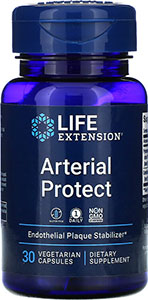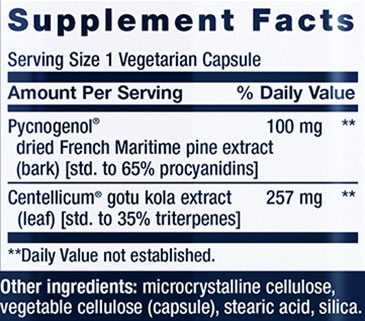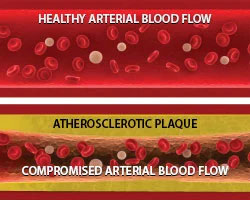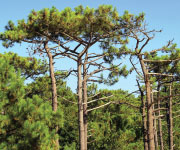

Arterial Protect
Contains: See Supplement Facts
Size: 30 Vegie Caps
Manufacturer: Life Extension
Suggested Retail Price: US$ 36.00

Price: US$ 33.00
- 30 vegetarian capsules
- Vascular protection
- Blood Pressure
Gotu kola & Pycnogenol® help stabilize plaque in the arteries
Lipids and other waste can accumulate in blood vessels, forming plaque in the arteries. This plaque must remain stable in order to support optimal cardiovascular health and function. By encouraging the health of the thin cell layer that lines arteries, the endothelium, Arterial Protect encourages plaque stability,inhibits inflammation and oxidative stress to support arterial health.
Studies show that the extracts in Arterial Protect can help maintain the health, structure and function of the arterial lining.
Arterial Protect Benefits
- Helps stabilize plaque & promote healthy arterial blood flow
- Inhibits oxidative stress & inflammation to support vascular health
- Promotes vascular & endothelial health
Clinically studied Gotu Kola and Pycnogenol® French maritime pine bark extracts encourage the body’s natural processes for regulating plaque in the arteries and promote healthy arterial circulation.
Gluten free
Non-GMO
Vegetarian
Pycnogenol® and Centellicum® are registered trademarks of Horphag Research and the use of this product is protected by international patents.
Dosage and Use
Take one (1) capsule daily, or as recommended by a healthcare practitioner.
For more info:
Impede Arterial Plaque Accumulation
Two plant extracts can reduce arterial plaque progression by 95% while promoting plaque stability to lessen the risk of acute arterial occlusion.
By Michael Downey, Health & Wellness Author.
Atherosclerosis remains the Achilles tendon of aging humans.
A key characteristic is accumulation of plaque inside coronary, carotid, and other arteries.1,2
The risk of a cardiovascular event is highest for those with the most advanced arterial plaques. There are often no symptoms until this process triggers a stroke or heart attack.3
A standardized extract derived from French maritime pine bark has been shown to halt plaque accumulation.
Supporting this, the plant extract Centella asiatica has been shown to help preserve the hard cap on existing atherosclerotic plaques, making them less likely to rupture and cause a fatal cardiovascular event.
Compelling studies reveal that when these plant extracts are combined, they provide more powerful benefits—for instance, reducing plaque progression by a compelling 95%!4
Let's examine how these natural compounds work.
What you need to know
- The risk of a lethal cardiovascular event is highest for those with the most advanced arterial plaque—usually causing no symptoms until this process triggers a stroke or heart attack.
- Two compounds, standardized extracts of French maritime pine bark and Centella asiatica, have been documented to safely target this lethal process.
- Studies show that—taken together—they slow and even reverse plaque accumulation, while also boosting the stability of deadly soft plaque to help prevent a plaque rupture.
French Maritime Pine Bark Extract Blocks Plaque

French maritime pine extract contains a complex mixture of compounds known as procyanidins and phenolic acids5,6 that help slow the progression of arterial plaque.4 How does it achieve this?
This pine bark extract alters fat metabolism and various cell-signaling factors (inflammatory cytokines) that contribute to plaque formation and progression.7,8
French maritime pine bark reduces a major inflammation-signaling molecular complex (nuclear factor kappaB), resulting in lower levels of inflammation.7,8 This is critical, because chronic inflammation is a major factor in the development of atherosclerosis.
Animal studies have documented that French maritime pine bark reduces areas of plaque and lipid deposition in mice with atherosclerosis. This is accompanied by reductions in total cholesterol and triglyceride levels and increases in protective high-density lipoprotein (HDL) cholesterol.8
Another way that French maritime pine bark reduces the progression of atherosclerotic plaque is by improving endothelial function.9,10 Evidence shows that it accomplishes this by stimulating a vital enzyme that produces nitric oxide. Nitric oxide is a signaling molecule that endothelial cells use to communicate with the smooth muscle cells in arterial walls—helping them to relax and open up arteries.11
Scientists demonstrated this ability in lab experiments in which they constricted tissue from the aorta, the main blood vessel leading from the heart. They did this by using norepinephrine and epinephrine which is normally released in response to stress. This mimicked what happens in human arteries when blood flow is reduced.11
When the aorta was pretreated with French maritime pine bark, this blood-vessel constriction was prevented due to increased synthesis of nitric oxide, which signaled arterial wall cells to relax. This process produced a wider artery and increased blood flow. Additionally, researchers found that increasing nitric oxide levels decreased platelet aggregation and the tendency to stick to vessel walls—which reduces the risks of blood clots and enlarging plaques.11
To validate these powerful and complementary actions, scientists conducted controlled clinical trials on human volunteers.
French Maritime Pine Bark Documented in Controlled Clinical Studies
When plaque and inflammation narrow the coronary arteries—which supply the heart with blood, oxygen, and nutrients, the result is coronary artery disease. To show how French maritime pine bark improves blood flow and endothelial function in patients with this condition, researchers conducted a randomized, placebo-controlled, crossover study on 23 patients with coronary artery disease.12
Patients received either placebo or 200 mg of French maritime pine bark daily for eight weeks. Then, after a two-week "washout" period, each patient received the opposite treatment for another eight weeks.
By using a measure of how much the brachial artery (the main artery to the forearm) dilated in response to changes in blood flow (flow-mediated dilation), researchers were able to assess endothelial function at the start of the study and after each treatment period.12

French Naritime Pine
While placebo treatment produced no significant changes, the pine bark extract treatment was shown to produce a significant 32% increase in endothelial function and in flow-mediated dilation.
Pine bark extract also reduced levels of compounds known as isoprostanes—an index of how much oxidized fat is present and a measure of overall oxidant stress while placebo treatment produced no change. These findings demonstrated the pronounced ability of this pine bark extract to slow the fundamental, early arterial changes that lead to plaque formation and progression.12
Next, scientists in Italy designed a study to test the effects of this pine bark extract on individuals who had no obvious atherosclerotic changes in their blood vessels and who had not yet developed any clinically relevant coronary artery disease. They limited the experiment to volunteers who had definitive risk factors, including borderline levels of high blood pressure, blood lipids, and blood sugar—like most aging people. And like most people, these study subjects were in an ideal position for early, preventive intervention.13
Of the 93 volunteers, 32 had elevated blood pressure, 31 had high blood lipids, and 30 had elevated blood sugar. All participants continued their medical management of symptoms, but half of the subjects also took 150 mg of French maritime pine bark extract per day. Measurements of flow-mediated dilation were taken at the outset of the study, at eight weeks, and again at 12 weeks.13
The researchers found an increase in flow-mediated dilation of 55% in the supplemented group after eight weeks and an increase of 66% after 12 weeks. Also, measuring blood flow by a different method—laser Doppler flux—the team demonstrated similar increases at 8 and 12 weeks. Control participants, however, showed no significant changes in blood flow.13
Keep in mind that these study participants reflected the same borderline status that applies to most people—no symptoms, but a growing risk for the endothelial dysfunction that leads to plaque formation, progression, and ultimately, a serious cardiovascular event. Stressing this point, the study author wrote that French maritime pine represents, “…an important preventive possibility for borderline hypertensive, hyperglycemic, and hyperlipidemic subjects.”13
Now, let's look at how this natural plaque-preventing pine bark extract can be complemented by another plant extract that reduces the instability—and thus, the lethal risk of pre-existing plaque.
Centella asiatica Demonstrated to Stabilize Existing Plaques
Gotu Kola Centella asiatica
Early on in the process, arterial plaques are soft on the inside but covered with a hard, thick, fibrous cap on the plaque surface that faces the blood flow.
As long as these plaques remain thick, they are stable, meaning they're firm enough not to pose a major risk of rupturing.14,15
Over time, this cap begins thinning and weakening, making plaque rupture more likely. The result is a deadlier, more unstable, softer plaque that may lead to ischemic stroke or heart attack.
So as critical as it is to prevent plaque buildup, scientists have also long sought a way to stabilize soft plaques.

Gotu Kola Centella asiatica
Centella asiatica, also known as gotu kola, is an Asian aquatic plant containing compounds (triterpenoids) that stabilize soft plaque by improving the synthesis of collagen.16-19 Collagen is a component of the thick caps that hold soft plaque in place.17,20
Furthermore, this plant extract helps inhibit progression of plaque by reducing the adhesion of immune system cells (monocytes) that promote atherosclerosis.21
Participants with soft plaque were given 60 mg of Centella asiatica extract three times daily. After 12 months, their carotid-artery plaque was denser (harder, safer) by an average of 30%.20
Then, in phase two, researchers used the same dose, but in a randomized, placebo-controlled trial.
The results showed that carotid-artery plaque stability significantly improved. MRI scans demonstrated reduced blood flow to the brain in 17% of controls, but only in 7% of the Centella asiatica group. And supplemented subjects experienced 41% fewer cardiovascular events.20
In a similar, placebo-controlled study of volunteers with soft (high-risk) plaque in their femoral artery (the major artery in the thigh), scientists found that 60 mg of Centella asiatica extract three times daily produced a 63% harder plaque—indicating reduced rupture risk—in just 12 months. Critically, plaque size increased 23% in controls while Centella-supplemented patients showed zero plaque-size increase.17
Scientists then decided to combine plaque-stabilizing Centella asiatica with plaque progression-inhibiting French maritime pine bark. Let's now examine some studies conducted with this dual-compound formula.
Clinical Effects of Dual-Compound Supplement
To demonstrate the atherosclerosis-inhibiting effects of combining French maritime pine with Centella asiatica, scientists enlisted individuals aged 45 to 60 who had no cardiovascular risk factors or symptoms—but who did have plaques that did not narrow their arteries more than 50% (class IV).4

Several groups were assigned different supplements along with lifestyle, diet, education, and exercise recommendations. After 30 months, using ultrasound, researchers found that the percentage of plaques that had worsened from class IV to V (blocking over 50% of an artery) was:4
21.3% in controls receiving only diet/lifestyle recommendations (worst-performing group),
16.6% with 100 mg aspirin (or ticlopidine, an antiplatelet drug, for aspirin-intolerant subjects),
8.4% with 50 mg standardized French maritime pine bark alone,
5.3% with 100 mg standardized French maritime pine bark alone,
4.0% with 100 mg standardized French maritime pine bark plus 100 mg aspirin (or ticlopidine), and
1.1% with 100 mg standardized French maritime pine bark plus 100 mg extract of Centella asiatica (best-performing group).
So in volunteers taking both compounds, plaque progression was an impressive 95% lower than in controls!4
Then, scientists assigned the same dosages to subjects with advanced atherosclerosis—meaning at least one class V arterial lesion. Class V involves an instance of over-50% blockage without symptoms, while class VI also involves symptoms such as numbness, tingling, pain, or other, more serious symptoms. After 42 months, the percentage with plaques that had progressed from class V to VI was:22
48% in controls (worst-performing group),
21% with taking aspirin or ticlopidine,
11% with 100 mg standardized French maritime pine bark plus aspirin,
10% with 100 mg standardized French maritime pine bark alone, and
6.5% with 100 mg standardized French maritime pine bark plus 100 mg extract of Centella asiatica (best-performing group).
The combination of standardized extracts of French maritime pine bark and Centella asiatica provided a 7.4-fold reduction in the risk of developing cardiovascular-disease symptoms compared to controls—and a nearly four-fold reduced risk of being hospitalized for a full-blown cardiovascular event.22
Next, scientists conducted a study that demonstrated the effects of this dual-nutrient formula in stabilizing soft arterial plaques—and in blocking the progression of plaque accumulation in aging arteries.23
They evaluated carotid plaque stability, before and after three months' supplementation, in 50 symptom-free volunteers with arterial plaque stenosis of less than 50% (class IV), high oxidative stress, and a mean age of 61.5 years. Daily for three months, half were given 150 mg of standardized extract of French maritime pine bark along with 225 mg of an extract of Centella asiatica. All patients also received standard management care.23
Compared to controls, supplemented patients significantly improved on the plaque stability index. The "white component" of their plaque substantially increased, based on ultrasound imaging, indicating improved plaque density and significant risk reduction. Also, plaques were decreased in length, height, and number. Free radicals in the supplemented group's plasma were significantly reduced. There were no adverse effects. By contrast, standard plaque management produced no significant improvements.23
Further Clinical Validation

Two recent studies further document the capacity of this dual-compound formula to both inhibit plaque progression and stabilize plaques.24,25
Scientists enlisted patients, aged 45 to 60, with at least one instance of atherosclerotic plaque of 50%-60% occlusion and divided them into three groups. All groups were managed with education, exercise, diet and lifestyle changes. One group also received 100 mg of standardized French maritime pine bark daily, while another group received 100 mg of the pine bark extract plus 100 mg daily of Centella asiatica.23
After four years, there was a significant reduction in plaque progression rates for both treatment groups, but the combined formula provided the "best effects" in terms of plaque thickness and length.
Angina and oxidative stress were less for both treatment groups (pine bark alone or pine bark + Centella). But heart attacks (myocardial infarctions) were fewer in the dual-extract group. The study author wrote that both the pine bark extract alone and the combined formula “reduce the progression of arterial plaques and the progression to clinical stages.”24
Then, a study team used a measure called echogenicity to assess (carotid-femoral) plaques in 79 asymptomatic patients with atherosclerosis risk factors—either mildly high blood pressure or elevated cholesterol—all of whom were given standard control management. Only 36 of these patients received daily supplements of both French maritime pine and Centella asiatica.25
After six months, compared to controls, the supplemented participants were found to have greater plaque-stability scores, better plaque "white component" (more density), fewer plaques, decreased maximum plaque height, and decreased plasma free radicals—with no adverse events.25
Clearly, French maritime pine bark and Centella asiatica extracts—both individually and especially combined—reduce plaque progression and promote plaque stability.
Summary

The accumulation of plaque inside the coronary and other arteries often occurs without symptoms up until a stroke or heart attack strikes.
Researchers have identified two natural compounds that safely target this lethal progression.
Together, they have been shown to slow and even reverse plaque accumulation, while boosting the stability of deadly soft plaque to help prevent a plaque rupture.
A combination of French maritime pine bark and Centella asiatica provides the backup that most adults need to support more comprehensive cardiovascular protection.
If you have any questions on the scientific content of this article, please call a Life Extension® Wellness Specialist at 1-866-864-3027.
References
Bentzon JF, Otsuka F, Virmani R, et al. Mechanisms of plaque formation and rupture. Circ Res. 2014 Jun 6;114(12):1852-66.
Fava C, Montagnana M. Atherosclerosis Is an Inflammatory Disease which Lacks a Common Anti-inflammatory Therapy: How Human Genetics Can Help to This Issue. A Narrative Review. Front Pharmacol. 2018;9:55.
Available at: https://www.nhlbi.nih.gov/health-topics/atherosclerosis#signs,-symptoms,-and-complications. Accessed August 21, 2018.
Belcaro G, Dugall M, Hosoi M, et al. Pycnogenol(R) and Centella Asiatica for asymptomatic atherosclerosis progression. Int Angiol. 2014 Feb;33(1):20-6.
D'Andrea G. Pycnogenol: a blend of procyanidins with multifaceted therapeutic applications? Fitoterapia. 2010 Oct;81(7):724-36.
Rohdewald P. A review of the French maritime pine bark extract (Pycnogenol), a herbal medication with a diverse clinical pharmacology. Int J Clin Pharmacol Ther. 2002 Apr;40(4):158-68.
Gu JQ, Ikuyama S, Wei P, et al. Pycnogenol, an extract from French maritime pine, suppresses Toll-like receptor 4-mediated expression of adipose differentiation-related protein in macrophages. Am J Physiol Endocrinol Metab. 2008 Dec;295(6):E1390-400.
Luo H, Wang J, Qiao C, et al. Pycnogenol attenuates atherosclerosis by regulating lipid metabolism through the TLR4-NF-kappaB pathway. Exp Mol Med. 2015 Oct 23;47:e191.
Badimon L, Hernandez Vera R, Vilahur G. Atherothrombotic risk in obesity. Hamostaseologie. 2013;33(4):259-68. Chistiakov DA, Revin VV, Sobenin IA, et al. Vascular endothelium: functioning in norm, changes in atherosclerosis and current dietary approaches to improve endothelial function. Mini Rev Med Chem. 2015;15(4):338-50.
Fitzpatrick DF, Bing B, Rohdewald P. Endothelium-dependent vascular effects of Pycnogenol. J Cardiovasc Pharmacol. 1998 Oct;32(4):509-15.
Enseleit F, Sudano I, Periat D, et al. Effects of Pycnogenol on endothelial function in patients with stable coronary artery disease: a double-blind, randomized, placebo-controlled, cross-over study. Eur Heart J. 2012 Jul;33(13):1589-97.
Hu S, Belcaro G, Cornelli U, et al. Effects of Pycnogenol(R) on endothelial dysfunction in borderline hypertensive, hyperlipidemic, and hyperglycemic individuals: the borderline study. Int Angiol. 2015 Feb;34(1):43-52. Cheruvu PK, Finn AV, Gardner C, et al. Frequency and distribution of thin-cap fibroatheroma and ruptured plaques in human coronary arteries: a pathologic study. J Am Coll Cardiol. 2007 Sep 4;50(10):940-9.
Leskinen MJ, Kovanen PT, Lindstedt KA. Regulation of smooth muscle cell growth, function and death in vitro by activated mast cells--a potential mechanism for the weakening and rupture of atherosclerotic plaques. Biochem Pharmacol. 2003 Oct 15;66(8):1493-8.
Gohil KJ, Patel JA, Gajjar AK. Pharmacological Review on Centella asiatica: A Potential Herbal Cure-all. Indian J Pharm Sci. 2010 Sep;72(5):546-56.
Incandela L, Belcaro G, Nicolaides AN, et al. Modification of the echogenicity of femoral plaques after treatment with total triterpenic fraction of Centella asiatica: a prospective, randomized, placebo-controlled trial. Angiology. 2001 Oct;52 Suppl 2:S69-73.
Incandela L, Cesarone MR, Cacchio M, et al. Total triterpenic fraction of Centella asiatica in chronic venous insufficiency and in high-perfusion microangiopathy. Angiology. 2001 Oct;52 Suppl 2:S9-13.
James JT, Dubery IA. Pentacyclic triterpenoids from the medicinal herb, Centella asiatica (L.) Urban. Molecules. 2009 Oct 9;14(10):3922-41.
Cesarone MR, Belcaro G, Nicolaides AN, et al. Increase in echogenicity of echolucent carotid plaques after treatment with total triterpenic fraction of Centella asiatica: a prospective, placebo-controlled, randomized trial. Angiology.2001 Oct;52 Suppl 2: S19-25.
Ivanov V, Ivanova S, Kalinovsky T, et al. Plant-derived micronutrients suppress monocyte adhesion to cultured human aortic endothelial cell layer by modulating its extracellular matrix composition. J Cardiovasc Pharmacol. 2008 Jul;52(1):55-65.
Belcaro G, Ippolito E, Dugall M, et al. Pycnogenol(R) and Centella asiatica in the management of asymptomatic atherosclerosis progression. Int Angiol. 2015 Apr;34(2):150-7.
Luzzi R, Belcaro G, Ippolito E. Carotid plaque stabilization induced by the supplement association Pycnogenol(R) and centella asiatica (Centellicum(R)). Minerva Cardioangiol. 2016 Dec;64(6):603-9.
Belcaro G, Dugall M, Ippolito E, et al. Pycnogenol(R) and Centella asiatica to prevent asymptomatic atherosclerosis progression in clinical events. Minerva Cardioangiol. 2017 Feb;65(1):24-31.
Belcaro G, Cornelli U. Variations in Echogenicity in Carotid and Femoral Atherosclerotic Plaques with Pycnogenol + Centella Asiatica Supplementation. Int J Angiol. 2017 Jun;26(2): 95-101.
• Free shipping on purchases of $200.00 or more
• Wholesalers - call/order toll free 877-266-5711
• Distributors and International Orders (non-US)
• Wholesalers - call/order toll free 877-266-5711
• Distributors and International Orders (non-US)
• Orders may be placed via regular mail. Click here for
order form. Print this form and mail it with payment to
our business mailing address.











